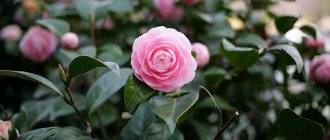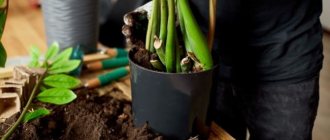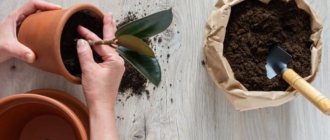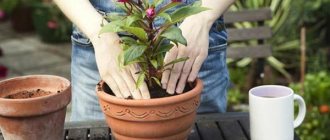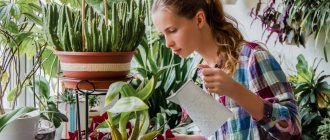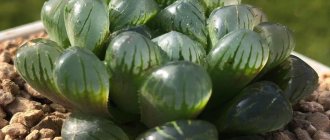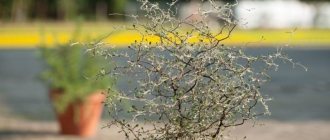- September 23, 2018
- Houseplants
- Yulia Kazakova
From time to time it is necessary to replant home flowers, otherwise they will wither or cease to please with their beautiful views. Any indoor plant needs to be replanted, since the amount of nutrients in its support gradually decreases. Each type of home flower has its own replanting frequency, depending on many factors. An important role in this process is played by the soil mixture, the container into which the flower will be moved, and compliance with the basic rules. It's worth figuring out when to repot indoor plants.
Transfer time
When to replant indoor plants depends on several factors:
- The plant did not produce flower stalks or new leaves during March.
- The leaves become smaller, and the indoor flower itself grows slowly.
- Roots are visible from the drainage holes, or the roots completely wrap around the earthen ball.
- The root system is in poor condition, since the soil mixture is not suitable for this type of flower.
Spring (late February to April) is the best time to replant indoor plants. The flower has come out of dormancy, and new shoots and leaves begin to appear on it. Transplantation is an impetus for the powerful development and growth of the plant during the growing season.
Choose the right soil
Probably the most important stage of replanting a plant is selecting the optimal soil for it. It is the characteristics of the soil that largely determine how the plant will tolerate the “move” and whether it will take root after it.
Creating the right soil is complex and requires serious knowledge and experience in crop production. Therefore, in my opinion, it is best to follow the path of least resistance and buy a ready-made substrate of the desired type at a gardening store. This is much more convenient, since manufacturers usually indicate on their products which plants the soil is suitable for. Accordingly, you only need to know the name of the plant being transplanted.
When to replant different types of indoor flowers
In summer, indoor flowers can be replanted only if necessary and very carefully, following all recommendations. Plants tolerate this process most easily during the active growing season.
However, there are species that are best replanted at the beginning of winter. These include cacti and succulents. Plants that are early flowering species need to be replanted only after flowering. Domestic flowers of bulbous species are subjected to such manipulation at the end of the dormant period. Coniferous species are replanted in the summer or in February, when their growth ends.
Ban on transplantation
It is forbidden to replant home flowers that were recently purchased in a store. Also, do not disturb the plants when they are flowering, as this will cause the buds to fall off. It is also prohibited to replant flowers during the dormant period, since they will not be able to recover quickly, damaged roots will begin to rot, and without them, the fresh substrate will begin to sour. Sick plants are also not subjected to such procedures, as this will cause additional stress and aggravate the situation.
What crops are best to germinate with seedlings?
In our country, due to the cold climate, many different crops have to be grown using seedlings, grown for both agricultural and ornamental purposes.
The most popular vegetables are tomatoes, peppers, eggplants and cucumbers. Almost every Russian summer resident sowed these crops for seedlings.
Less commonly, celery, cabbage, pumpkin and zucchini, leeks, and exhibition onions are planted on seedlings.
Some summer residents sow herbs for seedlings: basil, parsley, thyme, lemon balm, etc.
From flower seedlings, lobelia, petunia, eustoma, marigolds, salvia, purslane, zinnia, nasturtium, iberis, kobeya, balsam, etc. are grown.
In general, almost any crop (even potatoes) can be grown with seedlings. It’s just that, in fact, seedlings are a necessary measure, and not a whim of Russian vegetable growers.
Types of transplantation
The following types of flower transplantation are distinguished, depending on the volume of replacement of the soil mixture:
- Replacement of topsoil. This species is mainly used for replanting large indoor plants. The old layer is removed down to 5 cm, a new one is poured on top, which must be compacted. Most indoor plants benefit from changing the top layer of soil. It is better to perform such manipulations once every 3-6 months. Together with the substrate, deposited salts and soil fungi are removed, and additional substances are brought with the new soil.
- Incomplete transplant. A little soil mixture is left on the root system.
- Complete transplant. The roots are cleaned and the entire substrate is replaced.
Handling indoor plants
Most experts do not classify this type of houseplant transplant as a separate one. Transshipment of plants is the action in which a ball of earth is transferred to a larger container, and a soil mixture is added to it on top and on the sides. After this, the indoor plant is watered.
Transshipment is the safest option for plants. Most often it is used when the roots in the old pot no longer fit and are visible in the drainage holes. It does not provoke growth retardation in plants, so you can transship at any time of the year.
Transshipment is recommended for those plants that are actively growing and for those that do not cope well with transplantation (palm trees).
How can a beginner decide on the varieties of seeds for seedlings?
The most reliable thing is to look at vegetable plantings from experienced neighbors in the country, ask them about the characteristics of the varieties, and also read the advice of experienced summer residents in your region. The image on the seed packaging is always beautiful, but you need to know how the crop will behave in the conditions of its native land. Don’t forget to write down the names of varieties after excursions to neighboring plots.
To be on the safe side, it is better to choose not one or two, but several proven varieties - with good germination, smooth ripening, and resistance to many diseases. Read seed packages carefully.
Select mid-ripening and early-ripening varieties of peppers, eggplants and tomatoes to treat yourself to your first fruits at the end of July, and maybe earlier. If you have greenhouses, garden passion and time, buy late-ripening varieties of tomatoes. Late-ripening peppers and eggplants in Siberia do not have time to ripen, so if there is no heated greenhouse, then there is no need to risk it.
For myself, I wrote out the following most praised varieties, but for the sake of experiment, I also bought 1-2 varieties of each crop simply according to the label I liked.
Peppers:
Red Knight (aka Red Knight), Belladonna (aka White Lady), Swallow, Atlas F1 (the prefix F1 means a hybrid, usually high-yielding, not requiring pre-sowing treatment, but subsequently the seeds from hybrid fruits are not used to obtain their own), Star of the East , Shanghai, Aristotle, California miracle (although the latter has low germination rate). These varieties are thick-walled.
Eggplant:
Epic F1, King of the North F1, King of the Market F1, Mirabella, Black Beauty.
Tomatoes for salads and general purpose:
Bull's Heart (similar to Ox Ears), Miracle of the Earth, Mazarin, Orange, Malachite Box, De Barao, Scarlet Candles, Golden King. These are all greenhouse varieties.
Tomatoes for pickling:
Intuition, Cascade, Nocturne, Kostroma, Icicle, Parsley the Gardener, Black Moor, Red Giant, Labrador, F1 Jury (aka Bipop), F1 Intrigue. Most are greenhouse.
Tomato for long-term storage:
Marfa - for open ground.
Tomatoes for open ground, early ripening:
Wonder of the World, Early 83, Golden Heart, Red Banana, Russian Apple Tree, Snowdrop, Little Red Riding Hood, Zolotnik, Brawler (Fighter).
Leek:
the most win-win variety is Tango.
Choosing a pot for replanting a houseplant
The depth and width of the pot depends on the type of plant roots. It is recommended to choose a container size so that the previous one can easily fit into it. For young plants, a pot 2-3 cm larger is suitable, for adults - 3-5 cm. It is better to replant indoor flowers in a container only slightly larger than the previous one, rather than immediately using one that is too large.
The plant benefits from regular renewal of the substrate, and if the size of the pot is too large, the properties of the soil, free of roots, will quickly deteriorate.
There are plants that prefer to grow in a cramped pot. These flowers include: hippeastrum, epiphytic orchids. The main reason for the lack of flowering in hippeastrum is precisely the overly large pot.
Favorable days for sowing seedlings in 2022: calendar
✅ Table for planting vegetables for seedlings for 2022
| January | February | March | April | May | June | July | August | September | October | November | December |
